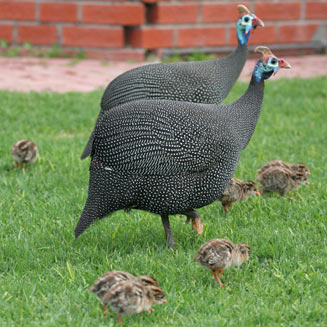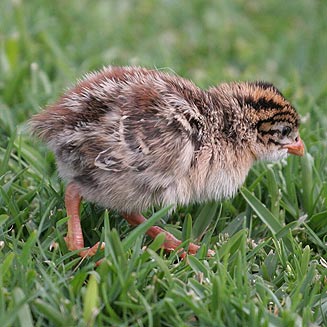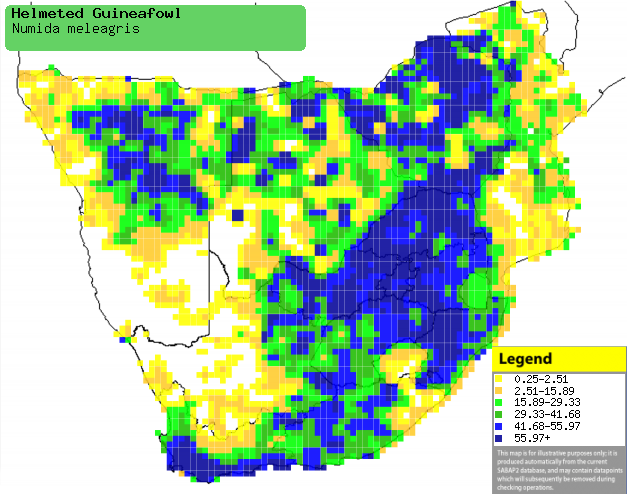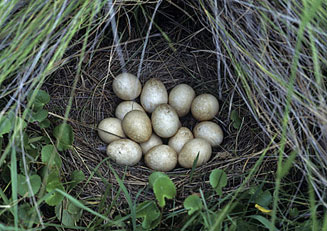Numida meleagris (Helmeted guineafowl)
Numida meleagris (Helmeted guineafowl)
Gewone tarentaal [Afrikaans]; Impangele [Xhosa]; iMpangele [Zulu]; Nkanga
[Kwangali]; Khaka [South Sotho]; Kgaka [North Sotho]; Hanga [Shona]; Imphangele
[Swazi]; Mhanghela [Tsonga]; Kgaka [Tswana]; Helmparelhoen [Dutch]; Pintade de
Numidie [French]; Helmperlhuhn [German]; Pintada da Guiné [Portuguese]
Life
> Eukaryotes >
Opisthokonta
> Metazoa (animals) >
Bilateria >
Deuterostomia > Chordata >
Craniata > Vertebrata (vertebrates) > Gnathostomata (jawed
vertebrates) > Teleostomi (teleost fish) > Osteichthyes (bony fish) > Class:
Sarcopterygii (lobe-finned
fish) > Stegocephalia (terrestrial
vertebrates) > Tetrapoda
(four-legged vertebrates) > Reptiliomorpha > Amniota >
Reptilia (reptiles) >
Romeriida > Diapsida > Archosauromorpha > Archosauria >
Dinosauria
(dinosaurs) > Saurischia > Theropoda (bipedal predatory dinosaurs) >
Coelurosauria > Maniraptora > Aves
(birds) > Order: Galliformes > Family: Numididae
 |
 |
| Helmeted guineafowls with chicks, Kleinmond, Western Cape, South Africa. [photo Duncan Robertson
©] |
Helmeted guineafowls chick, Kleinmond, Western Cape, South Africa. [photo Duncan Robertson
©] |
Distribution and habitat
Widespread in Africa south of the Sahara, but generally
absent from rain forest and desert. Within southern Africa, its distribution has
expanded with the spread of agriculture. Evidently, before 1900 it did not occur
in what is now known as the Western Cape.
|
 |
|
Distribution of Helmeted guineafowl in southern Africa,
based on statistical smoothing of the records from first SA Bird Atlas
Project (©
Animal Demography unit, University of
Cape Town; smoothing by Birgit Erni and Francesca Little). Colours range
from dark blue (most common) through to yellow (least common).
See here for the latest distribution
from the SABAP2. |
Predators and parasites
- Prey of the following raptors: Martial
eagle, Wahlberg's eagle,
Tawny eagle, African
hawk-eagle, Bateleur,
Cape eagle-owl, Verreaux's
eagle-owl.
- Blood parasites: Aegyptianella botuliformis,
Haemoproteus species, Leucocytozoon species and microfillariae.
- Worm parasites:
- Acanthocephalans: Mediorhynchus taeniatus
- Cestodes (tapeworms): Porogynia paronai,
Raillietina species, Ascometra species
- Nematodes: Ascaridia species, Dispharynx species,
Subulura species
- Ticks: Haemaphysalis silacea
Food
- Omnivorous
- Invertebrates (predominate in breeding season)
- Insects: e.g. grasshoppers, termites
- Plant matter (predominates in non-breeding season):
- bulbs
- plant stems (e.g. of Cyperus species)
- seeds (e.g. Devil's thorn Tribulus
terrestris)
Breeding
- The nest is made by the female and consists of a scrape
in the ground lined with grass stems and feathers and hidden among grass or
other vegetation.
 |
|
|
Helmeted guineafowl nest with eggs, Sericea
farm, South Africa. [photo Warwick Tarboton ©] |
|
- Breeding season. Breeding generally follows good rains.
Laying dates:
- Namibia, Botswana and Zimbabwe: January - March
- South Africa - summer rainfall region: peak from
October to March
- South Africa - winter rainfall region: peak from
September to December
- There can be as many as 41 eggs in a single nest but
this is due to egg dumping by other females. Thought that clutches of up to
12 eggs can be attributed to a single female. One egg is laid per day and
the female then incubates the clutch for 24-27 days before they hatch. She
sits tight for long periods, only feeding for one or two short periods per
day. Meanwhile, the male has gone off court other unpaired females and mate
with them. However, he gets back to the female soon after the chicks
hatch.
- Chicks are precocial and can feed for themselves within
24 hours. They can fly short distances by 14 days old. Downy appearance is
lost after 3 weeks and by 5 weeks they have juvenile plumage.
- In the first two weeks of life for the chicks, the male
cares for them most of all (up to 80% of his time) - helping to locate
insects for them and brooding them at night. Meanwhile, the female is
recovering from the time she spent incubating when she was not able to feed
very much.
- Male and female attack potential predators such as
baboons and jackals.
References
-
Hockey PAR, Dean WRJ and Ryan PG (eds) 2005. Roberts
- Birds of southern Africa, VIIth ed. The Trustees of the John Voelcker
Bird Book Fund, Cape Town.
|
